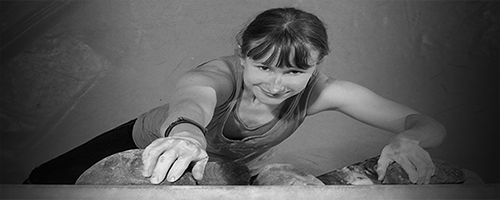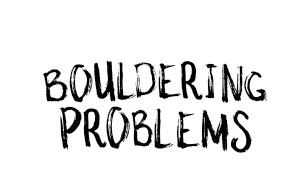Fancy Footwork and Leg Power Part 3: Find Your Stability
In previous posts, you saw how working those feet and legs in parts 1, and 2 of Fancy Footwork and Leg Power make a difference in your climbing. Now, here’s the last piece to make it all come together. In the final post of the series, we’ll work with gravity while up above on the wall. Plus, how you stand position yourself will affect your movement.
Gravity is a Mean Force
One thing a climber must consider is where is their center of gravity. Because gravity affects your outcome during a move or change in position. According to Eric J. Hörst, author of Learning to Climb Indoors, there are three things to be aware of when it comes to climbing.
- Balance
- Stability
- Application of Force
With these three factors in mind, one needs good footwork to accomplish them. You want to shift your body weight, so the shoe rubber sticks to the hold or rock and doesn’t slip. Whether it’s pushing off from a starting point or directing your foot to another spot, keeping your center of gravity in check pays off. If not, you’ll fall or try hard to resist gravity’s pull.
There are ways to achieve this, depending on the angle of the wall. One can climb straight on with the body right over the feet. This kind of climbing is what climbers first learn. If climbing on a less than vertical wall, twist your hips into or out from it to help keep your center of gravity close. Doing so forces your legs to push harder into the footholds. This movement can add inches for a long reach (which is great for shorties like me) and maintain contact with the rock.
Keep Me Upright
Besides, there are lower body positions and maneuvers that help you keep steady on the problem. These are also effective in helping your balance too. From Peter Beal’s Bouldering: Movement, Tactics, and Problem Solving, they are:
- Stemming
- Backstepping
- Dropknee
- Flagging
- Rockover
- Opposition
Stemming | |
|---|---|
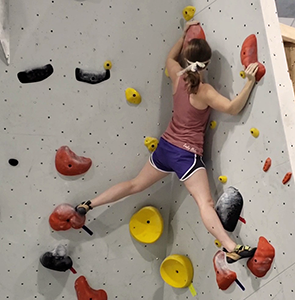 |
A stem is a simple position that allows a climber to distribute weight on both feet evenly. Stems are standard for inside corners or spaces where you can stand on opposing holds on two feet, almost without help from the hands. Even though it’s easy, there still needs to be a fair amount of balance and friction to stem. From this position, it’s an excellent opportunity to let the hands and arms rest. Once you recognize the chance to do this, take it. |
Backstepping | |
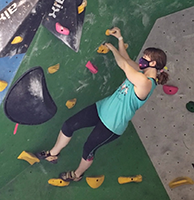 |
Despite sounding like a dance move, this positioning helps your stability while reaching back for a hold. Rock and Ice Magazine’s Rock Climbing Techniques article states a climber uses the outer edge of the feet and turn the hip so that the outside of it faces into the wall. Now, there’s extra reach with the hand on that same side. Backstepping is especially essential on overhung sections where you need every inch to step up and reach. |
Dropknee | |
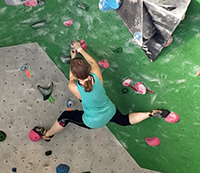 |
Dropknees combine parts of stemming and backstepping. Overall, it’s a backstepped foot placed closer to the hip and leveraged with an opposing foothold. This move allows you to find a hold and put a foot on it, so the toes and knee point down and twist away from the wall. Once secure, a climber can rotate the hip out, pull up, and into the wall. Usually, this frees the hand on the same side as the dropknee to reach. |
Flagging | |
 |
Keeping balance can be difficult if there are only good holds for one side of a problem, in Climbing Magazine writer Julie Ellison’s article Climbing Techniques: How to Flag, she describes a technique called flagging. It allows you to use a free-hanging foot as a counterbalance to make the next move, gain more reach, and prevent a barndoor swing.
You have a leg sticking out either to the side or behind you maintaining balance, so you don’t swing-out.
I use this move a lot when I’m climbing. When working on overhangs, I flag my legs, so I stay balanced and prevent swinging out. Sometimes with a side flag, you can twist your hips into the wall and press the instep of the flagging foot against the wall for some balance. You don’t want to do it for too long, so you don’t strain your leg or hip, but it helps. |
Rockover | |
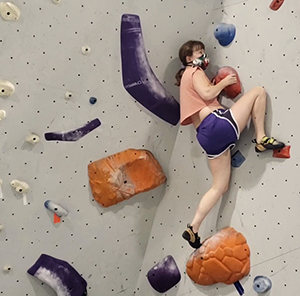 |
No, this isn’t giving rocks a makeover. A rockover is where you step high onto a foothold and move up enough to be able to sit on your foot and press up into a standing position, hopefully with little use of the hands. A good rockover is an excellent use of balance and turnout of the hips. A precaution with rockovers is overusing the knees and to not put too much stress on them. |
Opposition | |
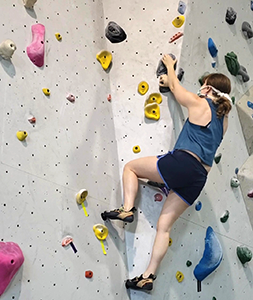 |
This more of an upper-body movement but works well with the lower body too. As the name suggests, using opposing forces to stay on the problem is what this does. Whether it’s leaning to the side to hold onto the holds or rock better or pushing away with the feet in the same manner, a constant state of tension is needed. Many problems allow or require this kind of movement to send it. |
Swinging Barn-doors

Earlier I mentioned the term “barn door” or “barndoor swing.” In Beal’s book and climbing slang, a barn door is when one swings from the wall or boulder if leaning away from it in an unstable position. Hence, you look like a swinging barn door from the “hinge” part. This action might result in falling off; if not, you’re able to catch yourself. That's why it’s essential to keep a good balance on problems, so this doesn’t happen.
Wrapping Up
There you have it, the parts one needs to know for good footwork and lower body movement for climbing. I hope you learned something from this series. Or remembered a few things you forgot. Until next time, happy bouldering!

